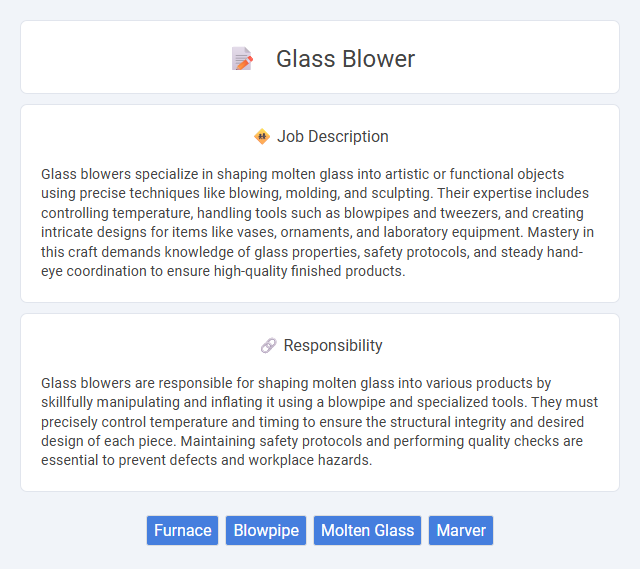
Glass blowers specialize in shaping molten glass into artistic or functional objects using precise techniques like blowing, molding, and sculpting. Their expertise includes controlling temperature, handling tools such as blowpipes and tweezers, and creating intricate designs for items like vases, ornaments, and laboratory equipment. Mastery in this craft demands knowledge of glass properties, safety protocols, and steady hand-eye coordination to ensure high-quality finished products.
Glassblowing likely requires individuals with strong physical stamina and excellent hand-eye coordination due to the demanding nature of handling molten glass. People who have a preference for creative, hands-on work and can maintain focus under heat and potential hazards might be more suitable for this job. Those prone to respiratory issues or who struggle with precision tasks may find this career less compatible with their health and skills.
Qualification
Glass blowers must possess specialized training in glassworking techniques, often acquired through apprenticeships or vocational programs. Key qualifications include steady hand-eye coordination, a strong understanding of furnace safety protocols, and the ability to manipulate molten glass using various tools. Certification in industrial safety and experience with both traditional and modern glassblowing methods enhance employability in this skilled craft.
Responsibility
Glass blowers are responsible for shaping molten glass into various products by skillfully manipulating and inflating it using a blowpipe and specialized tools. They must precisely control temperature and timing to ensure the structural integrity and desired design of each piece. Maintaining safety protocols and performing quality checks are essential to prevent defects and workplace hazards.
Benefit
A glass blower's job likely offers unique creative fulfillment through the hands-on crafting of intricate glass pieces, which can enhance job satisfaction. There is a probability of developing specialized skills that may increase opportunities for custom commissions or collaborations in artistic industries. The role might also provide a flexible work environment, with potential for freelance or studio-based work, appealing to those seeking autonomy.
Challenge
Glass blowing likely presents significant challenges due to the precise control required over molten glass's temperature and shape. The risk of burns and injuries might be high, demanding constant attention and safety measures. Mastery in this craft probably requires extensive practice to handle the unpredictable behavior of glass during shaping.
Career Advancement
Glass blowers can advance their careers by mastering complex techniques and specializing in artistic or industrial glass products. Gaining expertise in design software and automation tools enhances job prospects and opens opportunities for supervisory roles or entrepreneurship. Continuing education and certifications in materials science and safety protocols further support career growth and higher earning potential.
Key Terms
Furnace
A glass blower operates a high-temperature furnace to melt raw glass materials, typically maintaining temperatures above 2,000 degrees Fahrenheit to ensure optimal viscosity. Precise furnace control is crucial for shaping molten glass into intricate designs while preventing defects like bubbles or cracks. Mastery of furnace management directly impacts the quality, clarity, and durability of hand-blown glass products.
Blowpipe
A glass blower expertly shapes molten glass using a blowpipe, a crucial tool that allows precise control over the glass's form and thickness. Skilled manipulation of the blowpipe involves inflating the molten glass and rotating it to achieve symmetrical, detailed designs. Mastery of temperature and timing during the blowing process ensures the creation of durable, high-quality glassware.
Molten Glass
Working with molten glass requires precise control of temperature and timing to shape the material into intricate forms. Glass blowers manipulate molten glass at temperatures above 2,000 degrees Fahrenheit, using specialized tools to gather, blow, and sculpt the viscous substance. Mastery in handling the fluidity and viscosity of molten glass ensures the creation of high-quality, durable glass products.
Marver
A marver is an essential tool for glass blowers, used to shape and cool molten glass by rolling it on a smooth, flat surface typically made of steel or stone. This process helps achieve the desired thickness and smoothness before further manipulation or blowing. Mastery of marvering techniques directly impacts the precision and quality of the final glass product, making it a fundamental skill in glassblowing craftsmanship.
 kuljobs.com
kuljobs.com